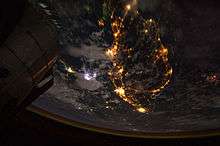Malay Peninsula



The Malay Peninsula (Malay: Semenanjung Tanah Melayu, سمننجوڠ تانه ملايو ; Thai: คาบสมุทรมลายู, rtgs: Khapsamut Malayu, pronounced [kʰâːp.sā.mùt mā.lāː.jūː]) is a peninsula in Southeast Asia. The land mass runs approximately north-south and, at its terminus, is the southernmost point of the Asian mainland. The area contains the southernmost tip of Myanmar, Peninsular Malaysia, and Southern Thailand.
The Titiwangsa Mountains are part of the Tenasserim Hills system, and form the backbone of the Peninsula. They form the southernmost section of the central cordillera which runs from Tibet through the Kra Isthmus (the Peninsula's narrowest point) into the Malay Peninsula.[1] The Strait of Malacca separates the Malay Peninsula from the Indonesian island of Sumatra while the south coast is separated from the island of Singapore by the Straits of Johor.
Etymology
The Malay term Tanah Melayu is derived from the word Tanah (land) and Melayu (Malays), thus it means "the Malay land". The term can be found in various pre-modern Malay texts, of which the oldest dating back to the early 17th century.[2] It is frequently mentioned in the Hikayat Hang Tuah, a well known classical work that began as oral tales associated with the legendary heroes of Melaka Sultanate. Tanah Melayu in the text is consistently employed to refer to the area under Melakan dominance.[3] In the early 16th century, Tomé Pires, a Portuguese apothecary who stayed in Melaka from 1512 to 1515, writes an almost identical term, Terra de Tana Malaio which he referred to the southeastern part of Sumatra, where the deposed Sultan of Melaka, Mahmud Shah established his exiled government. The 17th century's account of Portuguese historian, Emanuel Godinho de Erédia, noted on the region of "Malaios" surrounded by the Andaman Sea in the north, the entire Malacca Strait in the centre, a part of Sunda Strait in the south, and the western part of South China Sea in the east.[4]
Prior to the foundation of Melaka, reference to Malay peninsula was made in different terms from various foreign sources. According to several Indian scholars, the word Malayadvipa ("mountain-insular continent"), mentioned in the ancient Indian text, Vayu Purana, may possibly refer to the Malay peninsula.[5][6][7] Another Indian source, an inscription on the south wall of the Brihadeeswarar Temple, recorded the word Malaiur, referring to a kingdom in Malay peninsula that had "a strong mountain for its rampart".[8][9] The Greek source, Geographia, written by Ptolemy, labelled a geographical part of Golden Chersonese as Maleu-kolon, a term thought to derive from Sanskrit malayakolam or malaikurram.[10] While the Chinese chronicle of Yuan Dynasty mentioned the word Ma-li-yu-er, referring to a nation of Malay peninsula that threatened by the southward expansion of Sukhothai Kingdom under King Ram Khamhaeng.[11][12] During the same era, Marco Polo made a reference to Malauir in his travelogue, as a kingdom located in the Malay peninsula, possibly similar to the one mentioned in Yuan chronicle.[13][14]
In the early 20th century, the term Tanah Melayu was generally used by the Malays of the peninsula during the rise of Malay nationalism to describe uniting all Malay states on the peninsula under one Malay nation, although this ambition was largely realised with the formation of Persekutuan Tanah Melayu (Malay for "Federation of Malaya") in 1948.[15]
See also
References
- ↑ The Physical Geography of Southeast Asia, Avijit Gupta
- ↑ Mohamed Anwar Omar Din (2012). "Legitimacy of the Malays as the Sons of the Soil". Canadian Center of Science and Education. pp. 80–81. ISSN 1911-2025.
- ↑ Reid, Anthony (2010). Imperial alchemy : nationalism and political identity in Southeast Asia. Cambridge University Press. p. 95. ISBN 978-0-521-87237-9.
- ↑ Mohamed Anwar Omar Din (2011). "Asal Usul Orang Melayu: Menulis Semula Sejarahnya (The Malay Origin: Rewrite Its History)". Jurnal Melayu, Universiti Kebangsaan Malaysia. pp. 28–30. Retrieved 2012-06-04.
- ↑ Pande, Govind Chandra (2005). India's Interaction with Southeast Asia: History of Science,Philosophy and Culture in Indian Civilization, Vol. 1, Part 3. Munshiram Manoharlal. p. 266. ISBN 978-81-87586-24-1.
- ↑ Mukerjee, Radhakamal (1984). The culture and art of India. Coronet Books Inc. p. 212. ISBN 978-81-215-0114-9.
- ↑ Sarkar, Himansu Bhusan (1970). Some contributions of India to the ancient civilisation of Indonesia and Malaysia. Calcutta: Punthi Pustak. p. 8. ASIN B000PFNF5C.
- ↑ Langer, William Leonard (1973). An Encyclopedia of World History: Ancient, Medieval, and Modern, Chronologically Arranged. Houghton Mifflin Co. p. 362. ISBN 978-0-395-13592-1.
- ↑ Kotha, Satchidananda Murthy; S., Sankaranarayanan (2002). Life, thought, and culture in India, c. AD 300-1000. Centre for Studies in Civilizations. p. 121. ISBN 978-81-87586-09-8.
- ↑ Gerini, Gerolamo Emilio (1974). Researches on Ptolemy's geography of eastern Asia (further India and Indo-Malay archipelago. Oriental Books Reprint Corporation. p. 101. ISBN 81-7069-036-6.
- ↑ Guoxue (2003). "Chronicle of Mongol Yuan".
- ↑ Hall, Daniel George Edward (1981). History of South East Asia. Macmillan. p. 190. ISBN 978-0-333-24163-9.
- ↑ Cordier, Henri (2009). Ser Marco Polo; notes and addenda to Sir Henry Yule's edition, containing the results of recent research and discovery. Bibliolife. p. 105. ISBN 978-1-110-77685-6.
- ↑ Wright, Thomas (2004). The travels of Marco Polo, the Venetian: the translation of Marsden revised, with a selection of his notes. Kessinger Publishing, LLC. pp. 364–365. ISBN 978-1-4191-8573-1.
- ↑ Bunnell, Tim (2004). "From nation to networks and back again: Transnationalism, class and national identity in Malaysia". State/Nation/Transnation: Perspectives on Transnationalism in the Asia Pacific. Routledge: 1984. ISBN 0-415-30279-X.
External links
| Wikimedia Commons has media related to Malay Peninsula. |
 "Malakka". The New Student's Reference Work. 1914.
"Malakka". The New Student's Reference Work. 1914.
Coordinates: 7°00′N 100°00′E / 7.000°N 100.000°E